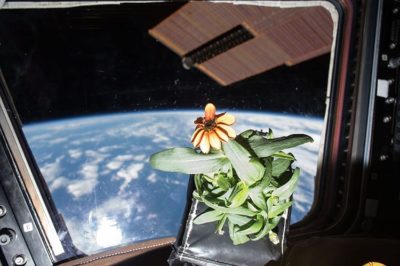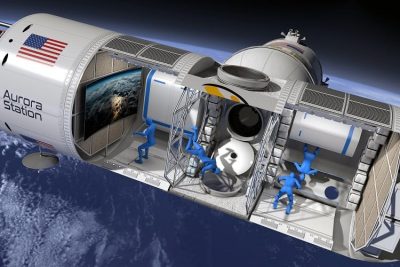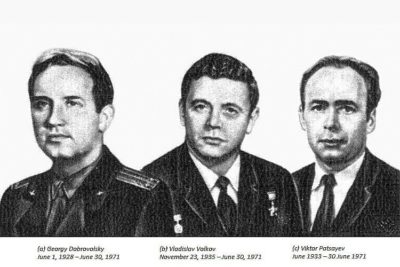Space Food: What Do Astronauts Eat Outside the Earth’s Atmosphere?
Share
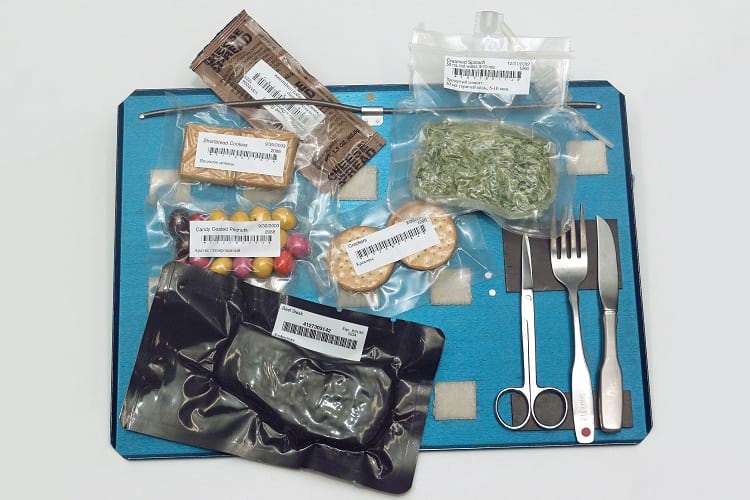
Space food presentation at Space Food Systems Laboratory in Johnson Space Center. (NASA)
Going out in space is one tough task that astronauts have to face. They are given rigorous training for months before their journey. They are meticulously prepared for a mission, man once only dreamt of. Although it may seem easy to us, but the moment a space explorer steps into the area of zero gravity, nothing is easy anymore.
Zero gravity not only hampers an astronaut’s psychological state but also disturbs their regular physiological functions. And to maintain a strict balance between both, it is necessary that the ones going in space make sure they eat the right kind of food. But did you know that those who travel in space pack special kind of foods with them, lest it becomes a major cause of concern for them and their space shuttle?
The need for space food
Long before freeze-dried and processed foods packed in small tubes were carried on space flights, scientists did not know that a procedure as simple as eating would cause trouble to astronauts. It was only when Russian cosmonaut Gherman Stepanovich Titov experienced space sickness for the first time and vomited his entire stomach’s contents, did researchers realize that food was one of the major factors that needed careful planning before men and women were sent out. A celebrated figure across the globe today, Titov travelled in space on August 6, 1961 following in the footsteps of his fellow countryman Yuri Gagarin. It was this ‘rare event’ that he experienced on Vostok II that brought on the need for special space food for astronauts.
A regular helping of routine food, which resulted in upset tummies, was completely done away with to avoid astronauts falling sick in space in the future. Bite-sized, dehydrated foods that were not just nutritious but also tasty, light-weight, able to be refrigerated and eaten as and when required, specially packaged space foods became the norm. This heralded a new era of supplying meals to astronauts that neither meddled with human physiology in space nor did it affect the astronaut’s psychological condition, deviating him/her from the task at hand.
First food in space
Learning from previous experience, John Glenn, an American astronaut, onboard Friendship 7 in 1962, was issued foods in compact tubes, from which he could easily eat while in a state of zero gravity. He became the first American to eat food in space on board a space shuttle. A combination of applesauce with sugar tablets in water was considered the first space food that Glenn carried with him.
Scientists found out that astronauts could easily ingest, swallow and even digest food while experiencing total weightlessness and so special meals that did not hamper with the natural process of eating began to be issued to astronauts from then on. Some packaged meals issued to Glenn also contained pureed meat and vegetables, which he could directly ingest from a tube, without spilling it around or letting it float away in a gravity-less environment.
Preparing food for space
Before packed meals are sent on board a space vehicle, it is carefully prepared by specially trained chefs, who know what it takes to transport food out of the Earth’s orbit. There are a variety of procedures that are undertaken before packaging and sending food in space. It is either freeze-dried, irradiated or thermo-stabilized, along with a host of other processes that make meals edible in space.
In the freeze-drying procedure, the food is first cooked and then quickly frozen in very low temperatures before putting it inside a vacuum chamber, where the water from it is dried off. This process does not compromise on the taste or the quality of the food. Some foods are also preserved before they are freeze-dried. Irradiated foods are packed in foil pouches before being exposed to gamma radiation to kill off the bacteria dwelling inside them. Irradiated foods do not pose a threat to human life. Thermo-stabilizing foods mean completely destroying the germs and microorganisms from certain food items so that they can be stored for a longer period of time before eating. Fish and most fruits undergo thermo-stabilization before being packed for space delivery.
Nuts and cookies are carried as they are, only that they are coated with gelatin so they don’t end up in crumbs that could float inside the pod. Some dried fruits like apricots, peaches, plums and pears are stripped of some of their moisture and issued to astronauts to be carried outside the Earth’s atmosphere.
Long before gourmet meals, just the way we eat on Earth were sent out in space for astronauts’ consumption, less appetizing and almost flavorless meals were issued to them. Packed in tubes, which had to be squeezed out like toothpaste, along with powdered granules of fruit juices or beverages were supplied to them. Astronauts then had to directly add hot water to the powder to rehydrate them before they could enjoy a hot cup of coffee or add cold water to have a sip of their favourite orange juice.

Russian space food. (Wikimedia Commons)

Ramen with an inlet to add hot water before consumption. (Tnk3a / Wikimedia Commons)
Before sophisticated methods like refrigerating and thermo-stabilizing were introduced onboard a spaceship, which are hassle-free methods of food preparation, freeze-drying was one of the most trusted ways of preparing food in space. Astronauts made use of hot or cold water guns, which injected water directly into the zip-locked pouches of food or plastic packets to rehydrate them so as to be eaten. Some space suits also had in-suit drinking devices, which were to be used in case of emergencies. These in-suit devices provided liquid foods in special ports, which were fitted in their helmets so that when things went wrong in their shuttle, they could live in space for a while with food stored in their suits.
Introduction of luxury space food
After John Glenn had the good fortune of eating pureed meat and vegetables, space food saw many alterations to suit the human physiology. More and more sophisticated, comfort foods were introduced, which were not only palatable but healthy as well. Squeeze tubes were discarded and thermo-stabilized pouches or wetpacks came into the picture. These packs made out of flexible aluminium foil or sterilized plastic kept food moist for a longer period of time and didn’t need rehydrating before consumption. These wetpacks allowed astronauts to enjoy bites of turkey, bacon and shrimp, helpings of chicken soup, tuna salad and even have cornflakes or beef sandwiches for breakfast, along with chocolate and butterscotch pudding for dessert.

Food trays provided in space shuttle have straps to help secure them on walls or platforms before using them. (RadioFan / Wikimedia Commons)
The Apollo crew was the first to be provided with utensils, including a spoon bowl, which was a plastic container with dehydrated food already packed inside. Hot water needed to be injected into the bowl to rehydrate the meal, which the astronauts could eat with a spoon. The wetness of the food allowed it (to) stick easily to the spoon and not float away in the shuttle. Luxury foods like chocolate brownies, rice cereals, scrambled eggs, macaroni and cheese, stews, along with apple ciders began getting more preference. Later during the 70’s the crew on board the Skylab mission was even provided with tables to sit down on and enjoy their meals together.
Food grown in space
Growing food grains or crops in space is not an easy task since the atmosphere is very different from what it is on Earth. Space is not a conducive environment to grow plants for consumption, yet a group of astronauts cultivated their own vegetables and ate them too. The astronauts of the Expedition 44 mission on board the International Space Station were successful in harvesting food in microgravity, which included some leafy vegetables.
The first space-grown vegetable was the red variety of lettuce, which the crew members cleaned with citric-based sanitized wipes before consuming it. Produced under the Veggie plant growth system, astronauts harvested half of the red and green lettuces, along with mustard, which they ate as salads. These crops were collected by a technique called cut-and-come-again harvesting, which allows the crew to reap more of the same plant after it grows again.
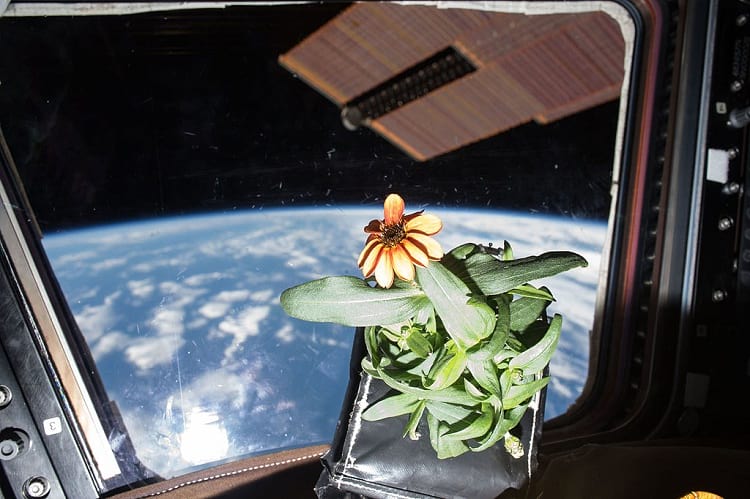
Photo of the first Zinnia flower in space. (NASA / Wikimedia Commons)
On the ISS, a special unit is dedicated entirely for growing plants, where in the near future, astronauts would be able to grow food for consumption as well as pursue gardening activities for recreational purposes. These space plants grow under red, blue, white and green LED lights in a fully-enclosed, environmentally-controlled chamber. This secure chamber allows the crops to grow in an almost natural surrounding with the correct amount of oxygen, moisture and right kind of temperature. If the Veggie system goes as planned, NASA hopes to broaden the spectrum, by adding a variety of foods that can be grown in space. Work on wheat, cabbage and a few fruits is already underway, as space travellers get to eat their test crops.
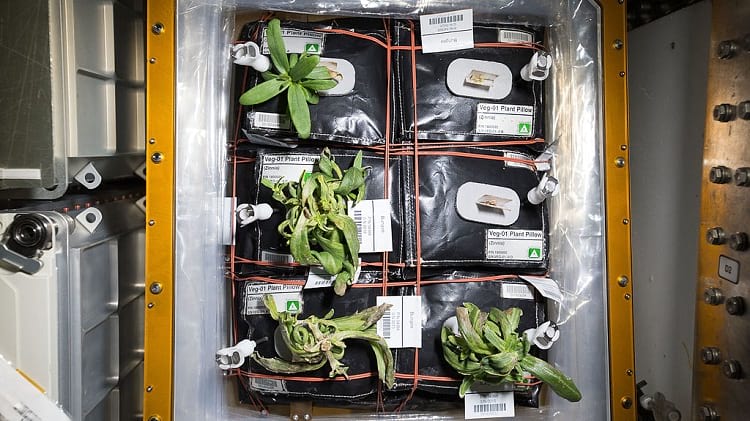
Plants growing in Veggie unit on ISS. (NASA / Wikimedia Commons)
When an astronaut smuggled food in space

Astronauts posing with a hamburger and tomato in space. (NASA)
Although the meals provided to the space travelers have come a long way, with many improvements made in the last five decades, there was one astronaut, who would have caused a major catastrophe for being disobedient. NASA’s second human spaceflight named the Gemini Project was underway in 1962 and John Young, an aeronautical engineer and test pilot, who later went on to become the Commander of Apollo 16 mission and also the ninth person to walk on the surface of the moon, smuggled a corned beef sandwich in space.
During his four-hour-long journey, he along with his colleague Gus Grissom were provided foods in plastic bags to consume. Not happy with the quality and taste of the freeze-dried space food, Young hid a sandwich in his spacesuit from a restaurant, which he later pulled out in space to eat only to realize what a huge mistake he had made. The crumbs of bread began floating in the space shuttle and there was a risk of those getting wedged between vents or parts of the equipment that kept the spaceship up and running. Grissom and Young could have died due to a major disaster or ended up being fatally wounded. Though both the crew members remained unharmed, he was reprimanded for his careless actions.
Young passed away at the age of 87 in January 2018, but his historic stunt is still etched in the minds of people. A replica of his corned beef sandwich remains preserved in the resin at the Grissom Memorial Museum in memory of the sandwich scandal in space.
A lot has already been done in the field of aeronautics and a lot more has to be accomplished; but the procedure of sending food in outer space remains the same with possibly a few changes being made in the quality, quantity and variety of foods that astronauts can enjoy in the confines of their space shuttle, thousands of miles away from their planet.
Enjoyed this article? Also, check out “A Glimpse into the Exciting World of Space Tourism“.
Fact Analysis:
STSTW Media strives to deliver accurate information through careful research. However, things can go wrong. If you find the above article inaccurate or biased, please let us know at [email protected]

